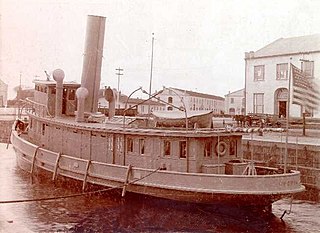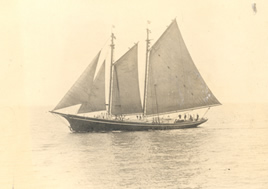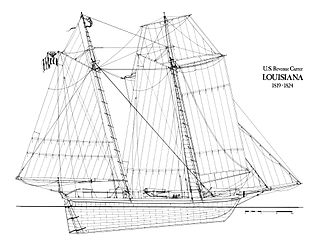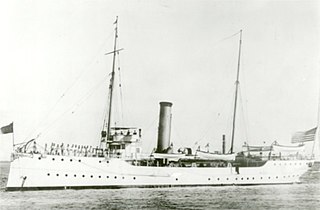
The United States Revenue Cutter Service was established by an act of Congress on 4 August 1790 as the Revenue-Marine upon the recommendation of Secretary of the Treasury Alexander Hamilton to serve as an armed customs enforcement service. As time passed, the service gradually gained missions either voluntarily or by legislation, including those of a military nature. It was generally referred to as the Revenue-Marine until 31 July 1894, when it was officially renamed the Revenue Cutter Service. The Revenue Cutter Service operated under the authority of the U.S. Department of the Treasury. On 28 January 1915, the service was merged by an act of Congress with the United States Life-Saving Service to form the United States Coast Guard.

USRC Windom was a revenue cutter of the United States Revenue Cutter Service and United States Coast Guard that served from 1896 to 1930. She was named for William Windom, the 33rd and 39th United States Secretary of the Treasury. She served during the Spanish–American War with the United States Navy. Windom was recommissioned as USCGC Comanche in 1915 and again served with the Navy as USS Comanche during World War I.

USS Bancroft was a United States Navy steel gunboat in commission from 1893 to 1898 and again from 1902 to 1905. She saw service during the Spanish–American War. After her U.S. Navy career, she was in commission in the United States Revenue Cutter Service from 1907 to 1915 as the revenue cutter USRC Itasca, and in the Revenue Cutter Service's successor service, the United States Coast Guard, as the cutter USCGC Itasca from 1915 to 1922. During her Coast Guard career, she saw service during World War I.

USRC Hudson, known for her service during the Battle of Cárdenas, was the United States Revenue Cutter Service's first vessel to have a steel hull and triple-expansion steam engine.
USRC Walter Forward was a schooner constructed for service with the United States Revenue-Marine. She was more commonly known as USRC Forward. Forward served with the United States Army and United States Navy in Mexican waters during the Mexican–American War and was commended for her actions during the Tabasco River landings by Commodore Matthew C. Perry, U.S. Navy. After the war, she was transferred to the United States Coast Survey for a short time as USCS Walter Forward before being returned to the Revenue-Marine for service during the 1850s and the American Civil War.

Worth G. Ross is known as the third Commandant of the Coast Guard, although he was never formally appointed to that position. Joining the United States Revenue Cutter Service in 1877, he graduated from the Revenue Cutter Service School of Instruction's first class in 1879. He held a variety of appointments during the late 19th century before being appointed Captain-Commandant of the service in 1905. In this capacity he commanded a number of cutters on the United States Gulf Coast and was responsible for moving the School of Instruction to Fort Trumbull, Connecticut. He was a relation of Brevet Brigadier General Samuel Ross (1822-1880), who commanded the 20th Connecticut Infantry during the American Civil War.

USRC Manning was a revenue cutter of the United States Revenue Cutter Service that served from 1898 to 1930, and saw service in the U.S. Navy in the Spanish–American War and World War I.

USRC Onondaga was an Algonquin-class cutter built for the U.S. Revenue Cutter Service for service on the Great Lakes. Because of the Spanish–American War, she was cut in half shortly before completion and transported to Ogdensburg, New York for service on the Atlantic coast although the war ended before she could be put into service. After the formation of the United States Coast Guard in 1915 she became USCGC Onondaga. She served as a patrol vessel at various Atlantic coast ports before World War I and unlike most Coast Guard cutters during World War I, she remained under the control of the Commandant of the Coast Guard. After the war she patrolled for a brief time based at New London, Connecticut before being decommissioned in 1923.

USRC Mohawk, was a steel steam powered revenue cutter built for the U.S. Revenue Cutter Service by William R. Trigg Company at Richmond, Virginia. Her primary duties in the Revenue Cutter Service and Coast Guard were assisting vessels in distress and enforcing navigational laws as well as a derelict destroyer. Mohawk was sunk after a collision with another vessel in October 1917.
USRC Forward was a revenue cutter constructed for the U.S. Revenue Cutter Service in 1882 by Pusey & Jones shipyard in Wilmington, Delaware. She was the second Revenue Cutter Service vessel named Forward and was named for Walter Forward, the fifteenth United States Secretary of the Treasury. The iron-hulled vessel originally cost US$72,750 and was powered by a two-cylinder steam engine with a topsail schooner brigantine sail pattern. Although Forward was considered a model ship at the time of its construction, it was severely underpowered and had unreliable machinery. The cost of repairs in the first fifteen years of operation was US$52,000.

USRC James C. Dobbin was a topsail schooner of the Cushing class (1853) named after President Franklin Pierce's Secretary of the Navy, James Cochrane Dobbin. She was initially stationed at Wilmington, North Carolina, but in 1856 was moved to Savannah, Georgia. She was seized by a secessionist mob on 3 January 1861 at Savannah and the officers and crew were held in irons. After the local customs inspector protested the seizure, Joseph E. Brown, the governor of Georgia ordered the cutter and crew released. Dobbin was the only revenue cutter based in the South to escape to the North before the Civil War. On 26 April 1861, she was ordered to Philadelphia, Pennsylvania, to receive heavier armament and then assigned to New York City. In 1863 Dobbin was reassigned to Portland, Maine, where she remained until being ordered to Baltimore, Maryland, in December, 1876 to be refitted as a training ship. The first eight cadets of the newly established Revenue Cutter School of Instruction reported aboard Dobbin and they set sail on their first practice cruise on 24 May 1877. One of the eight cadets was future Commandant of the Coast Guard, Worth G. Ross. The following summer, she was replaced by the newly constructed training cutter USRC Salmon P. Chase and Dobbin returned to service as a revenue cutter until she was sold in 1881.
The capture of the schooner Bravo was a naval battle fought in 1819 between United States Revenue Cutter Service cutters and one of Jean Lafitte's pirate ships.
USRC Alabama, was a wood-hull topsail schooner designed by William Doughty that was commissioned in the United States Revenue Marine from 1819 to 1833. Assigned the homeport of Mobile, Alabama, she sailed the Caribbean extensively with her sister ship, USRC Louisiana and was used mainly in anti-piracy activity.

USRC Louisiana, was a wood hull topsail schooner designed by William Doughty that was commissioned in the United States Revenue Marine from 1819 to 1824. Assigned the homeport of New Orleans, Louisiana, she sailed the Caribbean extensively and was used mainly in anti-piracy activity.

USRC Yamacraw, was a steel-hull flush-deck cutter that served in the United States Revenue Cutter Service from 1909 to 1937 and was the sister ship to the USRC Tahoma.

USRC Pamlico was a revenue cutter of the United States Revenue Cutter Service that served from 1907 to 1946 designed specifically to cruise inland waters and did so while stationed at New Bern, North Carolina her entire career.
David Henry Jarvis was a captain in the United States Revenue Cutter Service. During the harsh winter of 1897–1898, Jarvis, then serving as a first lieutenant aboard the U.S. Revenue Cutter Bear, led the Overland Relief Expedition, bringing a three-man rescue team with a herd of about 400 reindeer across 1,500 miles of tundra and pack-ice to Point Barrow, Alaska, to bring needed food to 265 whalers whose ships had become stranded in the ice off the northern Alaska coast.
USRC Active, was a revenue cutter of the United States Revenue Cutter Service in commission from 1867 to 1875. She was the fifth Revenue Cutter Service ship to bear the name.

USRC George S. Boutwell was a revenue cutter of the United States Revenue Cutter Service that served from 1873 to 1907 designed for cruising the southern coasts. She was named for George S. Boutwell, the 28th United States Secretary of the Treasury.

USRC Algonquin was an Algonquin-class cutter built for the U.S. Revenue Cutter Service for service on the Great Lakes. Because of the Spanish–American War, she was cut in half shortly before completion and transported to Ogdensburg, New York for service on the Atlantic coast although the war ended before she could be put into service. She was homeported at San Juan, Puerto Rico from 1905 to 1917. Algonquin served briefly for the U.S. Navy along the Atlantic Coast in the summer of 1898 before being returned to the Treasury Department. After the formation of the United States Coast Guard in 1915 the vessel became USCGC Algonquin. The ship served as a patrol vessel at Norfolk, Virginia at the beginning of World War I before being assigned convoy duty in the Mediterranean. In February 1919 Algonquin was transferred to the West Coast and served in the Pacific Northwest and Alaska until being decommissioned at San Francisco in December 1930.














